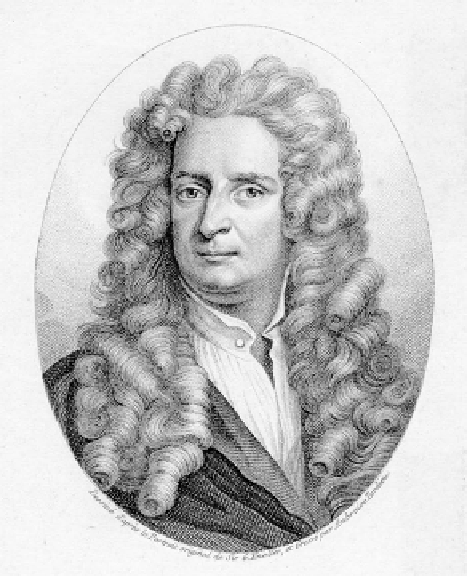Geoscience Reference
In-Depth Information
Table 7.1.
Wavelengths of absorption in the visible
and ultraviolet spectra by atmospheric gases
Chemical
Absorption
Gas name
formula
wavelengths (
m)
Visible/Near-UV/Far-UV Absorbers
Ozone
O
3
(g)
<
0.35, 0.45-0.75
<
Nitrate radical
NO
3
(g)
0.67
<
Nitrogen dioxide
NO
2
(g)
0.71
Near-UV/Far-UV Absorbers
Formaldehyde
HCHO(g)
<
0.36
Nitric acid
HNO
3
(g)
<
0.33
Far-UV Absorbers
Molecular oxygen
O
2
(g)
<
0.245
Carbon dioxide
CO
2
(g)
<
0.21
Water
H
2
O(g)
<
0.21
Molecular nitrogen
N
2
(g)
<
0.1
UV, ultraviolet.
gases that absorb visible or UV radiation. Of the gases,
all absorb UV, but only a few absorb visible radiation.
Gases that absorb visible or UV radiation are often, but
not always, photolyzed by this radiation into simpler
products.
The gases that affect UV radiation the most are
molecular oxygen
[O
2
(g)],
molecular nitrogen
[N
2
(g)], and
ozone
[O
3
(g)]. Oxygen absorbs wave-
lengths shorter than 0.245
Figure 7.1.
Sir Isaac Newton (1642-1727). Edgar Fahs
Smith Collection, University of Pennsylvania Library.
is divided into wavelengths of Newton's primary col-
ors,
blue
(0.38-0.5
m),
green
(0.5-0.6
m), and
red
(0.6-0.75
m).
When radiation passes through the Earth's atmo-
sphere, it is attenuated or redirected by absorption and
scattering by gases, aerosol particles, and hydrometeor
particles. These processes are discussed next.
m, and nitrogen absorbs
wavelengths shorter than 0.1
m. Oxygen and nitrogen
prevent nearly all solar wavelengths shorter than 0.245
m from reaching the troposphere.
In 1880, M. J. Chappuis found that ozone also
absorbed visible radiation between the wavelengths of
0.45
7.1.1. Gas Absorption
Absorption
occurs when radiative energy (e.g., from
the sun or Earth) enters a substance and is converted
to internal energy, changing the temperature of the
substance. The substance then reradiates some of the
internal energy back to the air at a longer (thermal-IR)
wavelength, heating the air. Absorption removes radi-
ation from an incident beam, reducing the amount of
radiation received past the point of absorption. Next,
absorption by gases is discussed with respect to the
solar spectrum.
m. The absorption bands in this
wavelength region are now called
Chappuis bands
.
In 1881, Walter N. Hartley first suggested that ozone
waspresent in the upper atmosphere and hypothesized
that the reason that the Earth's surface received lit-
tle radiation shorter than 0.31
m and 0.75
mwas because ozone
also absorbs these wavelengths. The absorption bands
of ozone below 0.31
marenowcalled the
Hart-
ley bands
.In1916, English physicists Alfred Fowler
(1868-1940) and Robert John Strutt (1875-1947; the
son of Lord Baron Rayleigh) showed that ozone also
weakly absorbs wavelengths between 0.31
7.1.1.1. Gas Absorption at Ultraviolet and
Visible Wavelengths
Gases selectively absorb radiation in different portions
of the electromagnetic spectrum. Table 7.1 lists some
m and
0.35
m. The bands of absorption in this region are
now called the
Huggins bands
.Ozone absorption of
UV and solar radiation, followed by reemission of





Search WWH ::

Custom Search